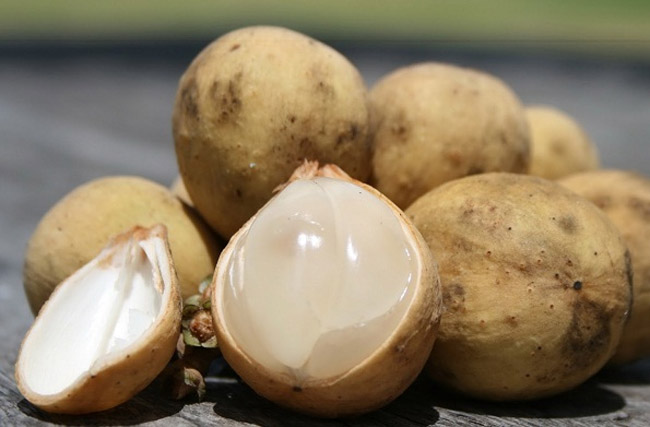Health Benefits of Rarest and Exotic fruits of the world

 Langsat or lanzones
Langsat or lanzones
Lansium domesticum, also known as langsat, buahluku or lanzones, is a species of
tree in the Mahogany family. The plant, which originates from western Southeast
Asia, bears edible fruit. It is the provincial flower for the Indonesian
province of South Sumatra.
The fruit can be elliptical, oval, or round, measuring 2 to 7 centimetres (0.79
to 2.8 in) by 1.5 to 5 centimetres (0.59 to 2.0 in) in size. Fruits look much
like small potatoes and are borne in clusters similar to grapes. The larger
fruits are on the variety known as duku. It is covered by thin, yellow hair
giving a slightly fuzzy aspect. The skin thickness varies with the varieties,
from 2 millimetres (0.079 in) to approximately 6 millimetres (0.24 in).
The fruit contains 1 to 3 seeds, flat, and bitter tasting; the seeds are covered
with a thick, clear-white aril that tastes sweet and sour. The taste has been
likened to a combination of grape and grapefruit and is considered excellent by
most. The sweet juicy flesh contains sucrose, fructose, and glucose. For
consumption, cultivars with small or undeveloped seeds and thick aril are
preferred.
L. domesticum is cultivated mainly for its fruit, which can be eaten raw. The
fruit can also be bottled in syrup. The wood is hard, thick, heavy, and
resilient, allowing it to be used in the construction of rural houses. Some
parts of the plant are used in making traditional medicine. The bitter seeds can
be pounded and mixed with water to make a deworming and ulcer medication. The
bark is used to treat dysentery and malaria; the powdered bark can also be used
to treat scorpion stings. The fruit's skin is used to treat diarrhea, and in the
Philippines the dried skin is burned as a mosquito repellent. The skin,
especially of the langsat variety, can be dried and burned as incense.
The greatest producers of lansium domesticum are Malaysia, Thailand, the
Philippines and Indonesia. The production is mostly for internal consumption,
although some is exported to Singapore and Hong Kong.
One serving of lanzones contains approximately 100 g of the edible portion of
the fruit. Per serving, lanzones contain 86.5 g of moisture, 0.8 g of protein,
9.5 g of carbohydrates and 2.3 g of fiber. Additionally, this fruit contains 20
g of calcium, 30 g of phosphorus, 13 IU of vitamin A, 89 mcg of thiamine, 124
mcg of riboflavin, 1 g of ascorbic acid and 1.1 mg of phytin per serving.

Health Benefits of Langsat or lanzones
1. Lanzones have several purported medicinal uses. According to the "Encyclopedia
of Natural Medicine," you can burn the dried peel from this fruit to drive away
mosquitoes.
2. The bark from the tree that grows the lanzone fruit can function as an
astringent to treat diarrhea.
3. Powder from the bark can also help to treat scorpion stings.
4. The lanzone fruit can serve as a febrifuge, meaning it lowers your body
temperature.
5. Lanzones contain riboflavin and thiamine, vitamin B-2 and B-1 respectively.
Riboflavin supports body growth and red blood cell production. Additionally,
riboflavin helps your body to release energy from carbohydrates. Our body uses
thiamine to break down sugars. Additionally, thiamine can help to treat several
nerve and heart conditions.
6. Lanzones also contain vitamin A, also known as retinol or carotenoids.
Vitamin A is a fat-soluble vitamin that plays a fundamental role in maintaining
healthy skin, teeth, soft and skeletal tissue and mucous membranes. Vitamin A
also functions as an eye pigment fundamental in night or low light situations.
7. Lanzones contain carotene, a powerful antioxidant. Antioxidants play a
fundamental role in protecting cells from free radicals, associated with many
medical disorders.
8. The mixture of powdered seeds and water are used for treatment of intestinal
worms.
9. The resin from bark was prescribed for flatulence (a state of excessive gas
in the alimentary canal), for swellings and as an antispasmodic (a drug used to
relieve or prevent spasms).
10. The resin may be useful in the treatment of inflammation and colic (acute
abdominal pain) of the gastro-intestinal tract.
